Will Russia have to invade its $130 billion pot of gold?

After waging war against Ukraine that triggered a humanitarian crisis as well as skyrocketing oil prices that fueled global inflation concerns, Russia has been hammered with a series of sanctions by Western governments in an attempt to weaken its economy.
Foreign nations have slapped economic sanctions on Vladimir Putin's government and among the most sweeping sanctions are efforts to cut Russia’s access to the global financial system.
Russian banks have been barred from using the Society for Worldwide Interbank Financial Telecommunications (SWIFT) payment system that connects banks in 200 countries and regions to more than 11,000 financial institutions globally.
Washington and its European allies have also moved to cut off the Russian central bank from overseas transactions, further restricting Russia’s ability to use its international reserves to fund the war.
The cost of Putin’s war
The actual cost of the Ukraine invasion on Russia may be far less than the magnitude of damage on Ukrainians, although it has definitely taken a toll on Russians as wars are expensive.
A recent study by Ukraine-based think-tank Center for Economic Recovery estimates that an almost 100-hour full-scale invasion cost the Russian economy $7 billion in direct losses including $2.7 billion of potential GDP loss in the next 40 years.
If the war drags on, Russia might have to bank on its reserves to continue funding its military.
How much foreign reserve does Russia have?
As of mid-February, before Russia started to invade Ukraine, the country had amassed $643 billion in international reserves, according to the Bank of Russia. But with the unprecedented sanctions imposed on the Russian central bank, much of the country’s foreign exchange reserves have been rendered useless.
Russian central bank assets held in US banks have also been frozen and financial institutions outside the US that hold dollars for the central bank will be unable to transfer the assets.
With the restricted access to the US dollar, Russia may be prompted to use its gold reserves to support its deteriorating economy. The central bank earlier this week suspended purchases of gold from banks amid increased demand from households, which the Bank of Russia attributed to the cancellation of value-added tax on consumers’ gold purchases. The central bank did not disclose when it will resume buying gold from banks.
Russia had built more than $130 billion worth of gold as of the end of January, accounting for about 22% of its reserves, data from the central bank showed.
A large portion of Russia’s foreign currency and gold reserves are kept in China, France, Japan, Germany and the US as of mid-2021, according to a now unavailable report by the Bank of Russia that was archived by Wayback Machine. Russia and China are seen as de-facto allies, making it easy for the Kremlin to recover its gold from Asia’s largest economy.
Targeting Russian gold to cripple Kremlin
However, with no signs of Putin backing down from the war, US lawmakers are now targeting Russia’s access to its gold. A bipartisan bill was introduced last week, aiming to apply sanctions to any American entities that transact or transport gold from Russia’s central bank or sell gold physically or electronically in Russia.
"Russia’s massive gold supply is one of the few remaining assets that Putin can use to keep his country’s economy from falling even further,” US Senator Angus King, one of the bill’s authors, said.
Acknowledging the Ukraine conflict’s impact on the Russian economy
Putin has acknowledged that the Russian economy had suffered a setback from the war, saying in televised remarks on Wednesday that Russia "will have to make deep structural changes in our economy.”
"I will not pretend that they will be easy or that they will not lead to a temporary increase in inflation and unemployment.”
On Sunday, International Monetary Fund Managing Director Kristalina Georgieva told CBS's "Face the Nation" program that Russia may default on its debts, triggering a deep recession in its economy this year.
The Russian ruble fell to 105.45 against the US dollar on Thursday.
Author

Mark O’Donnell
Blackbull Markets Limited
Mark O’Donnell is a Research Analyst with BlackBull Markets in Auckland, New Zealand.

















